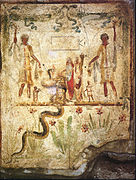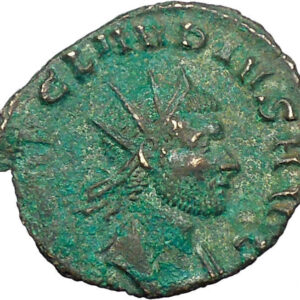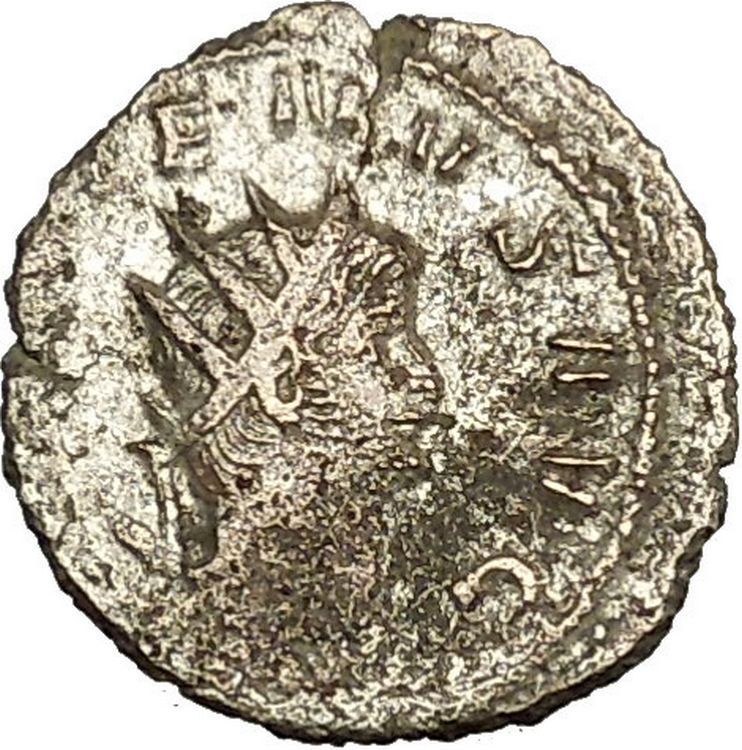|
Galerius – Roman Emperor : 305-311 A.D. –
Bronze Follis 25mm (6.63 grams) Cyzicus mint: 308-310 A.D.
Reference: RIC 53
GAL MAXIMIANVS P F AVG, Laureate head right.
GENIO AVGVSTI Exe: B/MKV, Genius standing left, holding patera and cornucopia.
You are bidding on the exact item pictured, provided with a Certificate of Authenticity and Lifetime Guarantee of Authenticity.

Head of a genius worshipped by Roman soldiers (found at Vindobona , 2nd century CE)
In ancient Roman religion , the genius was the individual instance of a general divine nature that is present in every individual person, place, or thing.
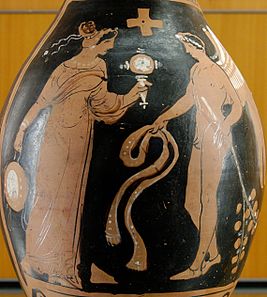
Winged genius facing a woman with a tambourine and mirror, from southern Italy, about 320 BC.
Nature of the genius
The rational powers and abilities of every human being were attributed to their soul, which was a genius. Each individual place had a genius (genius loci) and so did powerful objects, such as volcanoes. The concept extended to some specifics: the genius of the theatre, of vineyards, and of festivals, which made performances successful, grapes grow, and celebrations succeed, respectively. It was extremely important in the Roman mind to propitiate the appropriate genii for the major undertakings and events of their lives.
Specific genii

Bronze genius depicted as pater familias (1st century CE)
Although the term genius might apply to any divinity whatsoever, most of the higher-level and state genii had their own well-established names. Genius applied most often to individual places or people not generally known; that is, to the smallest units of society and settlements, families and their homes. Houses, doors, gates, streets, districts, tribes, each one had its own genius.The supreme hierarchy of the Roman gods, like that of the Greeks, was modelled after a human family. It featured a father, Jupiter (“father god”), who, in a patriarchal society was also the supreme divine unity, and a mother, Juno , queen of the gods. These supreme unities were subdivided into genii for each individual family; hence, the genius of each female, representing the female domestic reproductive power, was a Juno. The male function was a Jupiter.
The juno was worshipped under many titles:
- Iugalis, “of marriage”
- Matronalis, “of married women”
- Pronuba, “of brides”
- Virginalis, “of virginity”
Genii were often viewed as protective spirits, as one would propitiate them for protection. For example, to protect infants one propitiated a number of deities concerned with birth and childrearing : Cuba (“lying down to sleep”), Cunina (“of the cradle”) and Rumina (“of breast-feeding”). Certainly, if those genii did not perform their proper function well, the infant would be in danger.
Hundreds of lararia, or family shrines, have been discovered at Pompeii , typically off the atrium , kitchen or garden, where the smoke of burnt offerings could vent through the opening in the roof. A lararium was distinct from the penus (“within”), another shrine where the penates , gods associated with the storerooms, was located. Each lararium features a panel fresco containing the same theme: two peripheral figures (Lares) attend on a central figure (family genius) or two figures (genius and Juno) who may or may not be at an altar. In the foreground is one or two serpents crawling toward the genius through a meadow motif. Campania and Calabria preserved an ancient practice of keeping a propitious house snake, here linked with the genius. In another, unrelated fresco (House of the Centenary) the snake-in-meadow appears below a depiction of Mount Vesuvius and is labelled Agathodaimon, “good daimon “, where daimon must be regarded as the Greek equivalent of genius.
History of the concept
Origin
Etymologically genius (“household guardian spirit”) has the same derivation as nature from gēns (“tribe”, “people”) from the Indo-European root *gen-, “produce.” It is the indwelling nature of an object or class of objects or events that act with a perceived or hypothesized unity. Philosophically the Romans did not find the paradox of the one being many confusing; like all other prodigies they attributed it to the inexplicable mystery of divinity. Multiple events could therefore be attributed to the same and different divinities and a person could be the same as and different from his genius. They were not distinct, as the later guardian angels, and yet the Genius Augusti was not exactly the same as Augustus either. As a natural outcome of these beliefs, the pleasantness of a place, the strength of an oath, an ability of a person, were regarded as intrinsic to the object, and yet were all attributable to genius; hence all of the modern meanings of the word. This point of view is not attributable to any one civilization; its roots are lost in prehistory. The Etruscans had such beliefs at the beginning of history, but then so did the Greeks, the native Italics and many other peoples in the near and middle east.
Genii under the monarchy
No literature of the monarchy has survived, but later authors in recounting its legends mention the genius. For example, under Servius Tullius the triplets Horatii of Rome fought the triplets Curiatii of Alba Longa for the decision of the war that had arisen between the two communities. Horatius was left standing but his sister, who had been betrothed to one of the Curiatii, began to keen, breast-beat and berate Horatius. He executed her, was tried for murder, was acquitted by the Roman people but the king made him expiate the Juno of his sister and the Genius Curiatii, a family genius.
Republican genii
The genius appears explicitly in Roman literature relatively late as early as Plautus , where one character in the play, Captivi , jests that the father of another is so avaricious that he uses cheap Samian ware in sacrifices to his own genius, so as not to tempt the genius to steal it.In this passage, the genius is not identical to the person, as to propitiate oneself would be absurd, and yet the genius also has the avarice of the person; that is, the same character, the implication being, like person, like genius.
Implied geniuses date to much earlier; for example, when Horatius Cocles defends the Pons Sublicius against an Etruscan crossing at the beginning of the Roman Republic , after the bridge is cut down he prays to the Tiber to bear him up as he swims across: Tiberine pater te, sancte, precor …, “Holy father Tiber, I pray to you ….” The Tiber so addressed is a genius. Although the word is not used here, in later literature it is identified as one.
Horace describes the genius as “the companion which controls the natal star; the god of human nature, in that he is mortal for each person, with a changing expression, white or black”.
Imperial genii
Octavius Caesar on return to Rome after the final victory of the Roman Civil War at the Battle of Actium appeared to the Senate to be a man of great power and success, clearly a mark of divinity. In recognition of the prodigy they voted that all banquets should include a libation to his genius. In concession to this sentiment he chose the name Augustus , capturing the numinous meaning of English “august.” This line of thought was probably behind the later vote in 30 BC that he was divine, as the household cult of the Genius Augusti dates from that time. It was propitiated at every meal along with the other household numina.The vote began the tradition of the divine emperors ; however, the divinity went with the office and not the man. The Roman emperors gave ample evidence that they personally were neither immortal nor divine.

Inscription on votive altar to the genius of Legio VII Gemina by L. Attius Macro (CIL II 5083)
If the genius of the imperator , or commander of all troops, was to be propitiated, so was that of all the units under his command. The provincial troops expanded the idea of the genii of state; for example, from Roman Britain have been found altars to the genii of Roma, Roman aeterna, Britannia, and to every legion , cohors , ala and centuria in Britain, as well as to the praetorium of every castra and even to the vexillae . Inscriptional dedications to genius were not confined to the military. From Gallia Cisalpina under the empire are numerous dedications to the genii of persons of authority and respect; in addition to the emperor’s genius principis, were the geniuses of patrons of freedmen, owners of slaves, patrons of guilds, philanthropists, officials, villages, other divinities, relatives and friends. Sometimes the dedication is combined with other words, such as “to the genius and honor” or in the case of couples, “to the genius and Juno.”
Surviving from the time of the empire hundreds of dedicatory, votive and sepulchral inscriptions ranging over the entire territory testify to a floruit of genius worship as an official cult. Stock phrases were abbreviated: GPR, genio populi Romani (“to the genius of the Roman people”); GHL, genio huius loci (“to the genius of this place”); GDN, genio domini nostri (“to the genius of our master”), and so on. In 392 AD with the final victory of Christianity Theodosius I declared the worship of the Genii, Lares and Penates to be treason, ending their official terms. The concept, however, continued in representation and speech under different names or with accepted modifications.
Roman iconography
Coins
The genius of a corporate social body is often a cameo theme on ancient coins: a denarius from Spain, 76-75 BC, featuring a bust of the GPR (Genius Populi Romani, “Genius of the Roman People”) on the obverse ; an aureus of Siscia in Croatia , 270-275 AD, featuring a standing image of the GENIUS ILLVR (Genius Exercitus Illyriciani, “Genius of the Illyrian Army”) on the reverse; an aureus of Rome, 134-138 AD, with an image of a youth holding a cornucopia and patera (sacrificial dish) and the inscription GENIOPR, genio populi Romani, “to the genius of the Roman people,” on the reverse.
|
|
|
Scene from Lararium, House of Iulius Polybius, Pompeii
|
|
|
|
Agathodaimon (“good divinity”), genius of the soil around Vesuvius
|
|
|
|
Unknown Roman genius near Pompeii, 1st century BC
|
|
Modern-era representations
|
|
|
Genius of love, Meister des Rosenromans, 1420-1430
|
|
|
|
Genius of victory, Michelangelo (1475-1564
|
|
|
|
Genius of Palermo , Ignazio Marabitti, c. 1778
|
|
|
|
Genius of liberty, Augustin Dumont , 1801-1884
|
|
|
|
Genius of Alexander, Marie Louise Elisabeth Vigée-Lebrun, 1814
|
|
|
|
Genius of war, Arturo Melida y Alinara (1849-1902)
|

|
Galerius Maximianus (ca. 260 – late April or early May 311), formally Gaius Galerius Valerius Maximianus was Roman Emperor from 305 to 311. //
Early life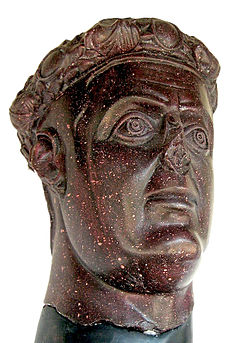
Galerius was born on a small farm estate, on the site where he later built his palace, Felix Romuliana.[5] His father was a Thracian and his mother Romula was a Dacian woman, who left Dacia because of the Carpians’ attacks.[10] He originally followed his father’s occupation, that of a herdsman, where he got his surname of Armentarius (Latin: armentum, herd). He served with distinction as a soldier under Emperors Aurelian and Probus, and in 293 at the establishment of the Tetrarchy, was designated Caesar along with Constantius Chlorus, receiving in marriage Diocletian’s daughter Valeria (later known as Galeria Valeria), and at the same time being entrusted with the care of the Illyrian provinces. Soon after his appointment, Galerius would be dispatched to Egypt to fight the rebellious cities Busiris and Coptos.[11]
War with Persia
Invasion, counterinvasion
In 294, Narseh , a son of Shapur who had been passed over for the Sassanid succession, came into power in Persia. Narseh probably moved to eliminate Bahram III , a young man installed by a noble named Vahunam in the wake of Bahram II’s death in 293.[12] In early 294, Narseh sent Diocletian the customary package of gifts, but within Persia he was destroying every trace of his immediate predecessors, erasing their names from public monuments. He sought to identify himself with the warlike reigns of Ardashir (r. 226-41) and Shapur (r. 241-72), the same Shapur who had sacked Roman Antioch, skinned the Emperor Valerian (r. 253-260) to decorate his war temple.[13]
In 295 or 296, Narseh declared war on Rome. He appears to have first invaded western Armenia, retaking the lands delivered to Tiridates in the peace of 287. He would occupy the lands there until the following year.[14] Narseh then moved south into Roman Mesopotamia, where he inflicted a severe defeat on Galerius, then commander of the Eastern forces, in the region between Carrhae (Harran, Turkey) and Callinicum (Ar-Raqqah, Syria).[15] Diocletian may or may not have been present at the battle,[16] but would present himself soon afterwards at Antioch, where the official version of events was made clear: Galerius was to take all the blame for the affair. In Antioch, Diocletian forced Galerius to walk a mile in advance of his imperial cart while still clad in the purple robes of an emperor.[17] The message conveyed was clear: the loss at Carrhae was not due to the failings of the empire’s soldiers, but due to the failings of their commander, and Galerius’ failures would not be accepted.[18] (It is also possible that Galerius’ position at the head of the caravan was merely the conventional organization of an imperial progression, designed to show a Caesar’s deference to his Augustus.)[19]

Detail of Galerius attacking Narseh on the Arch of Galerius at Thessaloniki , Greece , the city where Galerius carried out most of his administrative actions.[20]
Galerius had been reinforced, probably in the spring of 298, by a new contingent collected from the empire’s Danubian holdings.[21] Narseh did not advance from Armenia and Mesopotamia, leaving Galerius to lead the offensive in 298 with an attack on northern Mesopotamia via Armenia.[18] Diocletian may or may not have been present to assist the campaign.[22] Narseh retreated to Armenia to fight Galerius’ force, to Narseh’s disadvantage: the rugged Armenian terrain was favorable to Roman infantry, but unfavorable to Sassanid cavalry. Local aid gave Galerius the advantage of surprise over the Persian forces, and, in two successive battles, Galerius secured victories over Narseh.[23]
During the second encounter, Roman forces seized Narseh’s camp, his treasury, his harem, and his wife along with it.[23] Narseh’s wife would live out the remainder of the war in Daphne, a suburb of Antioch, serving to the Persians as a constant reminder of Roman victory.[18] Galerius advanced into Media and Adiabene , winning continuous victories, most prominently near Erzurum,[20] and securing Nisibis (Nusaybin, Turkey) before October 1, 298. He moved down the Tigris, taking Ctesiphon, and gazing onwards to the ruins of Babylon before returning to Roman territory via the Euphrates.[24]
Peace negotiations
Narseh had previously sent an ambassador to Galerius to plead for the return of his wives and children, but Galerius had dismissed this ambassador, reminding him of how Shapur had treated Valerian.[21] The Romans, in any case, treated Narseh’s captured family with tact, perhaps seeking to evoke comparisons to Alexander and his beneficent conduct towards the family of Darius III .[18] Peace negotiations began in the spring of 299, with both Diocletian and Galerius presiding. Their magister memoriae (secretary) Sicorius Probus was sent to Narseh to present terms.[21]
The conditions of the peace were heavy:[18] Persia would give up territory to Rome, making the Tigris the boundary between the two empires. Further terms specified that Armenia was returned to Roman domination, with the fort of Ziatha as its border; Caucasian Iberia would pay allegiance to Rome under a Roman appointee; Nisibis, now under Roman rule, would become the sole conduit for trade between Persia and Rome; and Rome would exercise control over the five satrapies between the Tigris and Armenia: Ingilene , Sophanene (Sophene), Arzanene (Aghdznik), Corduene , and Zabdicene (near modern Hakkâri , Turkey). These regions included the passage of the Tigris through the Anti-Taurus range; the Bitlis pass, the quickest southerly route into Persian Armenia; and access to the Tur Abdin plateau. With these territories, Rome would have an advance station north of Ctesiphon, and would be able to slow any future advance of Persian forces through the region.[25] Under the terms of the peace Tiridates would regain both his throne and the entirety of his ancestral claim, and Rome would secure a wide zone of cultural influence in the region.[21] The fact that the empire was able to sustain such constant warfare on so many fronts has been taken as a sign of the essential efficacy of the Diocletianic system and the goodwill of the army towards the tetrarchic enterprise.[26]

Detail of the Arch of Galerius in Thessaloniki .
Persecution of Christians
Main article: Diocletian Persecution
Christians had lived in peace during most of the rule of Diocletian. The persecutions that began with an edict of February 24, 303, were credited by Christians to Galerius’ work, as he was a fierce advocate of the old ways and old gods. Christian houses of assembly were destroyed, for fear of sedition in secret gatherings.
Diocletian was not anti-Christian during the first part of his reign, and historians have claimed that Galerius decided to prod him into persecuting them by secretly burning the Imperial Palace and blaming it on Christian saboteurs. Regardless of who was at fault for the fire, Diocletian’s rage was aroused and he began one of the last and greatest Christian persecutions in the history of the Roman Empire .
It was at the insistence of Galerius that the last edicts of persecution against the Christians were published, beginning on February 24, 303, and this policy of repression was maintained by him until the appearance of the general edict of toleration, issued from Nicomedia in April 311, apparently during his last bout of illness, in his own name and in those of Licinius and Constantine (see Edict of Toleration by Galerius ). Lactantius gives the text of the edict in his moralized chronicle of the bad ends to which all the persecutors came, De Mortibus Persecutorum (“On the Deaths of the Persecutors”, chapters 34, 35). This marked the end of official persecution of Christians.
Rule as Augustus
After the elevation of Constantius I and Galerius to the rank of Augusti, two new Caesars were required to supply their place, and to complete the system of the Imperial government. The two persons whom Galerius promoted to the rank of Caesar were very much Galerius’ creatures, and he hoped to enhance his authority throughout the empire with their elevation.[27]
First was Maximinus Daia , whose mother was Galerius’ sister. An inexperienced youth with little formal education, he was invested with the purple, exalted to the dignity of Caesar, and assigned the command of Egypt and Syria. Second was Severus , Galerius’ comrade in arms; he was sent to Milan to receive the possession of Italy and Africa. According to the forms of the constitution, Severus acknowledged the supremacy of the western emperor; but he was absolutely devoted to the commands of his benefactor Galerius, who, reserving to himself the intermediate countries from the confines of Italy to those of Syria, firmly established his power over three quarters of the empire.[27]
His hopes were dashed when his colleague Constantius died at York in 306 and the legions elevated his son Constantine to the position of Augustus. Galerius only discovered this when he received a letter from Constantine, who informed him of his father’s death, modestly asserted his natural claim to the succession, and respectfully lamented that the enthusiastic violence of his troops had not allowed him to obtain the Imperial purple in the regular and constitutional manner. The first emotions of Galerius were those of surprise, disappointment, and rage; and, as he could seldom restrain his passions, he threatened to burn both the letter and the messenger.[28]
But when he had time to reconsider his position, he inevitably saw that his chances of winning a war against Constantine was doubtful at best, especially given that he was well aware of Constantine’s strengths as Constantine had been his guest for some time at Nicomedia , not to mention the attachment of the troops to him[27]. Therefore, without either condemning or ratifying the choice of the British army, Galerius accepted the son of his deceased colleague as the ruler of the provinces beyond the Alps; but he gave him only the title of Caesar, and the fourth rank among the Roman princes, whilst he conferred the vacant place of Augustus on his favourite Severus.
The ambitious spirit of Galerius was only just gotten over this disappointment when he beheld the unexpected loss of Italy to Maxentius . Galerius’ need for additional revenue had persuaded him to make a very strict and rigorous examination of the property of his subjects for the purpose of a general taxation. A very minute survey was taken of their real estates; and, wherever there was the slightest suspicion of concealment, torture was used to obtain a sincere declaration of their personal wealth. Italy had traditionally been exempt from any form of taxation[27], but Galerius ignored this precedent, and the officers of the revenue already began to number the Roman people, and to settle the proportion of the new taxes. Italy began to murmur against this indignity and Maxentius used this sentiment to declare himself emperor in Italy, to the fury of Galerius. Therefore, Galerius ordered his colleague Severus to immediately march to Rome, in the full confidence that, by his unexpected arrival, he would easily suppress the rebellion[27]. Severus was quickly captured and executed by Maximian , who had once again been elevated to the rank of co-emperor, this time by his son Maxentius.
The importance of the occasion needed the presence and abilities of Galerius. At the head of a powerful army collected from Illyricum and the East, he entered Italy, determined to revenge the death of Severus and to punish the rebellious Romans. But due to the skill of Maximian, Galerius found every place hostile, fortified, and inaccessible; and though he forced his way as far as Narni , within sixty miles of Rome, his control in Italy was confined to the narrow limits of his camp.
Seeing that he was facing ever-greater difficulties, Galerius made the first advances towards reconciliation, and dispatched two officers to tempt the Romans by the offer of a conference, and the declaration of his paternal regard for Maxentius, reminding them that they would obtain much more from his willing generosity that anything that might have been obtained through a military campaign[27]. The offers of Galerius were rejected with firmness, his friendship refused, and it was not long before he discovered that unless he retreated, he might have succumbed to the fate of Severus. It was not a moment too soon; large monetary gifts from Maxentius to his soldiers had corrupted the fidelity of the Illyrian legions. When Galerius finally began his withdrawal from Italy, it was only with great difficulty that he managed to stop his veterans deserting him[27].
In frustration, Galerius allowed his legions to ravage the countryside as they passed northwards. Maxentius declined to make a general engagement.
With so many emperors now in existence, in 308 Galerius, together with the retired emperor Diocletian and the now active Maximian, called an imperial ‘conference’ at Carnuntum on the River Danube to rectify the situation and bring some order back into the imperial government. Here it was agreed that Galerius’ long-time friend and military companion Licinius , who had been entrusted by Galerius with the defense of the Danube while Galerius was in Italy, would become Augustus in the West, with Constantine as his Caesar. In the East, Galerius remained Augustus and Maximinus remained his Caesar. Maximian was to retire, and Maxentius was declared a usurper.
Galerius’ plan soon failed. The news of Licinius’ promotion was no sooner carried into the East, than Maximinus, who governed, the provinces of Egypt and Syria, rejected his position as Caesar, and, notwithstanding the prayers as well as arguments of Galerius, exacted, the equal title of Augustus[27]. For the first, and indeed for the last time, six emperors administered the Roman world. And though the opposition of interest, and the memory of a recent war, divided the empire into two great hostile powers, their mutual fears and the fading authority of Galerius produced an apparent tranquility in the imperial government.
The last years of Galerius saw him relinquishing his aspirations towards being the supreme emperor of the empire, though he managed to retain the position of first among equals. He spent the remainder of his years enjoying himself and ordering some important public works, such as discharging into the Danube the superfluous waters of Lake Pelso , and the cutting down the immense forests that encompassed it[27].
Death
Galerius died on 5 May 311 from a horribly gruesome disease described by Eusebius , possibly some form of bowel cancer , gangrene or Fournier gangrene .
Gamzigrad-Romuliana , Palace of Galerius near Zaječar in Serbia he had constructed in his birthplace, was inscribed into the World Heritage List in June 2007.
|










